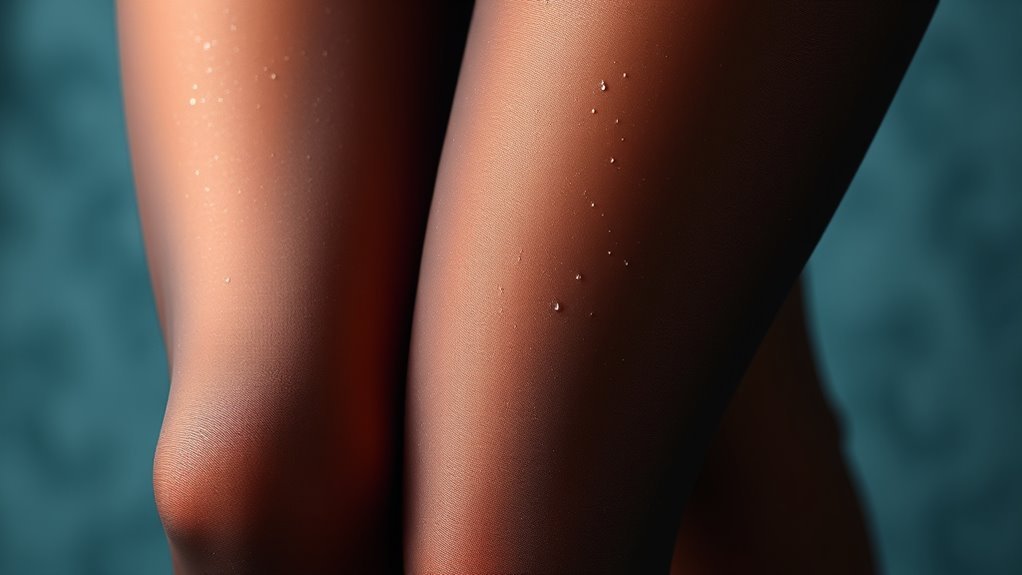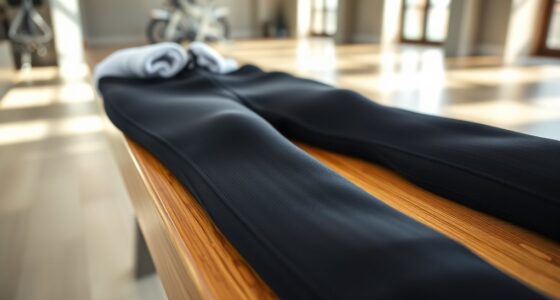Tights influence your body temperature by trapping heat and managing moisture, helping your body stay warm or cool as needed. When properly chosen with fabric thickness and breathable materials, they insulate effectively without overheating. Wind, humidity, and airflow can challenge this balance, reducing their warmth. Good tights support circulation and heat distribution, aiding your body’s natural processes. If you want to discover how to select the best tights for comfort in different conditions, keep exploring these tips.
Key Takeaways
- Moisture-wicking tights keep skin dry, aiding in effective heat retention and preventing heat loss through dampness.
- Tight-fitting, insulating fabrics trap body heat, supporting thermal regulation during cold conditions.
- Environmental factors like wind and humidity increase heat loss, challenging tights’ ability to maintain body temperature.
- Proper fabric thickness and material selection enhance insulation, balancing warmth and breathability.
- Compression tights promote blood circulation, ensuring even heat distribution and improving overall thermoregulation.
How Tights Affect Heat Retention and Loss

Tights play a critical role in controlling how your body retains or loses heat. By using effective layering techniques, you can optimize warmth and comfort. For example, wearing moisture-wicking tights underneath thicker layers helps manage sweat, preventing dampness that can lead to heat loss. Proper moisture management keeps your skin dry, which is essential for maintaining body temperature. Tight-fitting tights trap heat close to your skin, providing insulation without adding bulk. Choosing tights made from materials with good breathability ensures excess moisture escapes while retaining warmth. Additionally, selecting tights with advanced fabric technology can further improve moisture control and thermal regulation. Remember, layering and moisture management work together to regulate heat transfer. When you prioritize these aspects, you stay warmer during cold weather, and you prevent unnecessary heat loss, making tights an indispensable part of your thermoregulation strategy.
The Role of Fabric Thickness and Material in Insulation
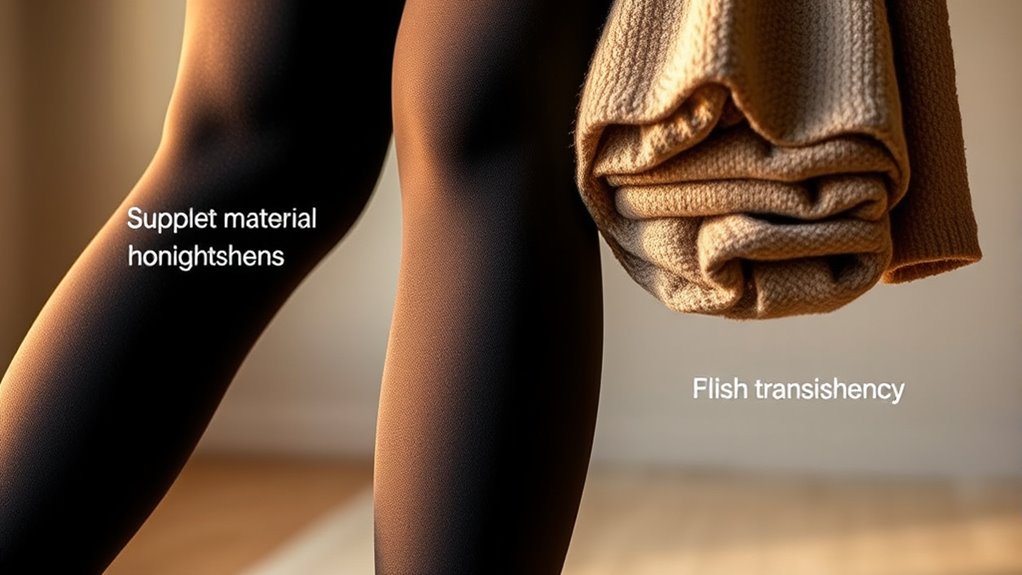
The thickness and material of tights substantially influence their insulating properties. Thicker fabrics generally provide better insulation by trapping more air, helping you stay warm. However, the material also plays a vital role. Natural fibers like wool offer excellent warmth and moisture wicking properties, keeping sweat away from your skin. Synthetic fibers like polyester or nylon can be lightweight yet effective insulators, especially when designed with fabric breathability in mind. Choosing tights with the right fabric balance ensures you stay warm without overheating. Look for options that combine thickness with breathable materials to optimize insulation and comfort. Proper fabric selection helps regulate temperature, preventing overheating or chill, which is essential for maintaining body temperature during various activities. Additionally, understanding the signs of spoilage in lemon juice can help ensure you use fresh ingredients in your clothing or health routines.
Body’s Natural Thermoregulation Mechanisms
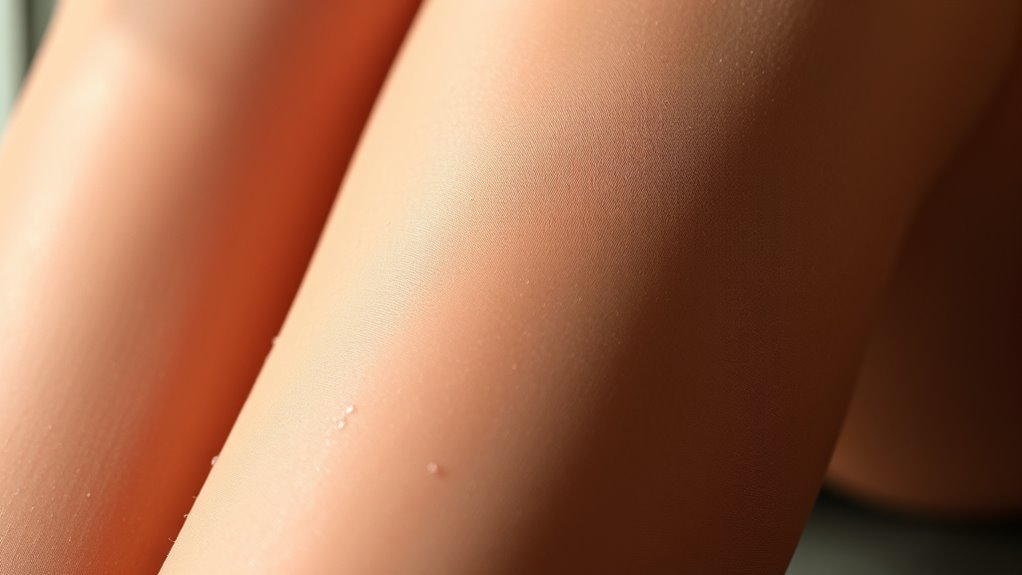
Your body actively works to maintain a stable internal temperature through natural thermoregulation mechanisms. When you feel warm, your metabolic rate increases slightly, generating more heat. To cool down, your sweat glands produce sweat, which evaporates from your skin, removing excess heat. This sweat evaporation is essential for cooling your body efficiently. Additionally, the color accuracy of your skin can slightly change with temperature variations, affecting how you perceive your body’s heat. Conversely, when you’re cold, your body constricts blood vessels near the surface to conserve heat, reducing heat loss. Shivering also kicks in, generating heat through rapid muscle movements. These mechanisms work together seamlessly, balancing heat production and loss. Your body constantly monitors internal and external conditions, adjusting processes like sweat evaporation and blood flow to keep your temperature steady. This complex system ensures you stay comfortable, whether it’s hot or cold outside.
Impact of Tights on Blood Circulation and Heat Distribution

Wearing tights can help improve your blood flow by gently compressing your legs, which encourages better circulation. This compression also promotes a more even distribution of heat across your muscles. As a result, tights can enhance your body’s ability to stay warm and comfortable during colder days. Additionally, the use of fabric decorating markers can personalize your tights, making them both functional and stylish.
Enhanced Blood Flow
When you wear tights, they apply gentle pressure that promotes better blood flow throughout your legs. This pressure encourages vascular dilation, allowing blood vessels to expand and facilitate improved circulation. By supporting ideal blood flow, tights help prevent blood pooling, which can cause discomfort or swelling. Enhanced circulation ensures that oxygen and nutrients reach your muscles more efficiently, aiding in recovery and reducing fatigue. Additionally, better blood flow helps maintain consistent heat distribution across your legs, supporting your body’s thermoregulatory processes. As a result, your muscles stay warmer and more energized during activity. Proper circulation is essential for overall muscle health and performance. Overall, tights not only improve circulation but also help your body more effectively manage heat, making them a valuable tool for both comfort and performance.
Uniform Heat Spread
Because tights promote improved blood circulation, they help distribute heat more evenly across your legs. This uniform heat spread enhances comfort and minimizes cold spots, especially in layered outfits. When planning layering strategies, tights act as a thermal buffer, ensuring consistent warmth beneath skirts or shorts. Fashion considerations also come into play; choosing the right material and thickness can optimize heat distribution without sacrificing style. For colder days, thicker tights retain more heat and support better circulation, while lighter options suit milder weather. Properly fitted tights prevent bunching or constriction, aiding in even heat flow. Additionally, understanding the Vortex concept can help you maintain a positive mindset and emotional balance, which can influence your body’s natural thermoregulation processes. Overall, tights not only keep you warm but also help your body manage temperature more effectively, making them a practical element of your wardrobe for maintaining consistent heat across your legs.
Environmental Factors That Influence Tights’ Effectiveness
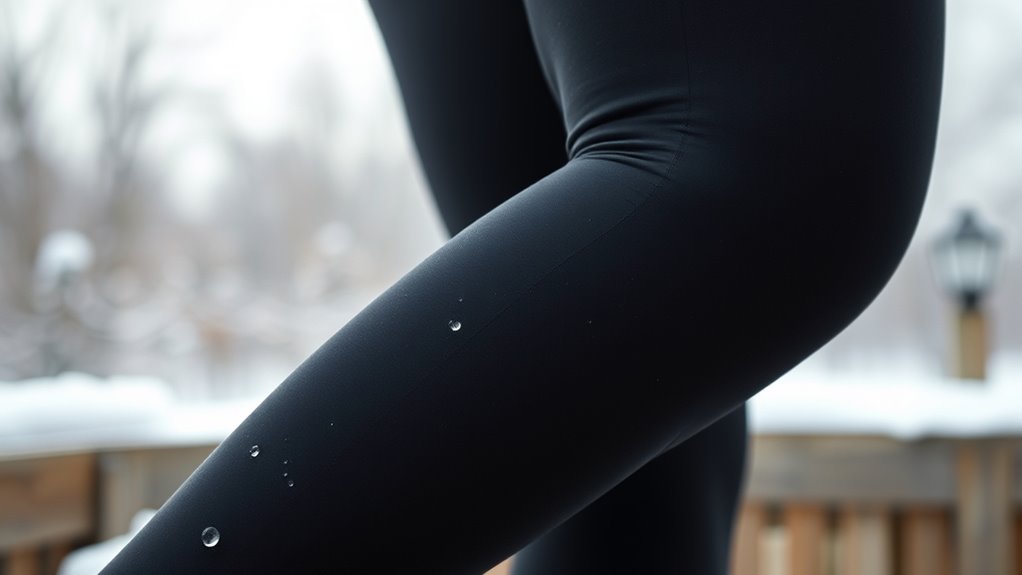
Environmental conditions can substantially affect how well your tights keep you warm. Changes in temperature, wind, and airflow can either boost or diminish their insulating properties. Additionally, humidity levels play a vital role in maintaining or losing heat through your tights. For example, high humidity can reduce thermal insulation by increasing moisture transfer, which impacts overall comfort and warmth. Moreover, understanding thermal efficiency can help you select the best tights for varying climates.
Temperature Variability Effects
Temperature fluctuations can considerably impact how well tights perform in different conditions. When temperatures vary, maintaining thermal comfort becomes challenging, and you may need to adjust your clothing layering accordingly. In cold weather, tights alone might not provide enough insulation, so layering with thermal leggings or adding outerwear can help trap heat. Conversely, in warmer conditions, lightweight or breathable tights help prevent overheating. Variability in temperature demands flexibility in your wardrobe choices to ensure consistent comfort and effective thermoregulation. Recognizing how external factors influence your tights’ insulating properties allows you to adapt your clothing strategies, keeping your body temperature stable across fluctuating environments. Incorporating portable camping gear such as lightweight and packable options can help manage environmental changes effectively, ensuring that tights support your comfort without sacrificing mobility or performance.
Wind and Airflow Impact
Have you ever noticed how wind can make tights feel colder or less effective? Wind causes airflow disruption around your legs, increasing heat loss through convection. When air moves rapidly over your skin or tights, it creates a wind chill effect that drops the perceived temperature, even if the actual temperature stays the same. This enhanced cooling reduces the insulating properties of your tights, making you feel colder faster. Wind chill is especially noticeable during outdoor activities, where gusts can strip away warmth more quickly. To counteract this, opt for tights with wind-resistant layers or wear additional clothing layers to block airflow. Being aware of wind’s impact helps you choose the right tights and layering strategies to maintain body warmth effectively. Additionally, selecting culturally appropriate outdoor clothing can help adapt to regional weather conditions and improve thermoregulation.
Humidity’s Role in Warmth
Humidity can markedly influence how warm your tights feel, especially in damp conditions. High humidity levels lead to moisture accumulation inside and outside your tights, reducing insulation. When moisture builds up, your body struggles to retain heat, making you feel colder. To combat this, humidity control becomes essential. Imagine:
- Sweating during a winter run, with moisture seeping into your tights and chilling your skin.
- Walking through foggy, damp streets, where humidity keeps your tights damp and less effective.
- Wearing tights in a humid room, causing sweat to linger and impair warmth retention.
- Understanding how certain fabrics and tights’ material can help manage moisture and improve insulation in humid environments.
Tips for Choosing Tights to Optimize Warmth and Comfort
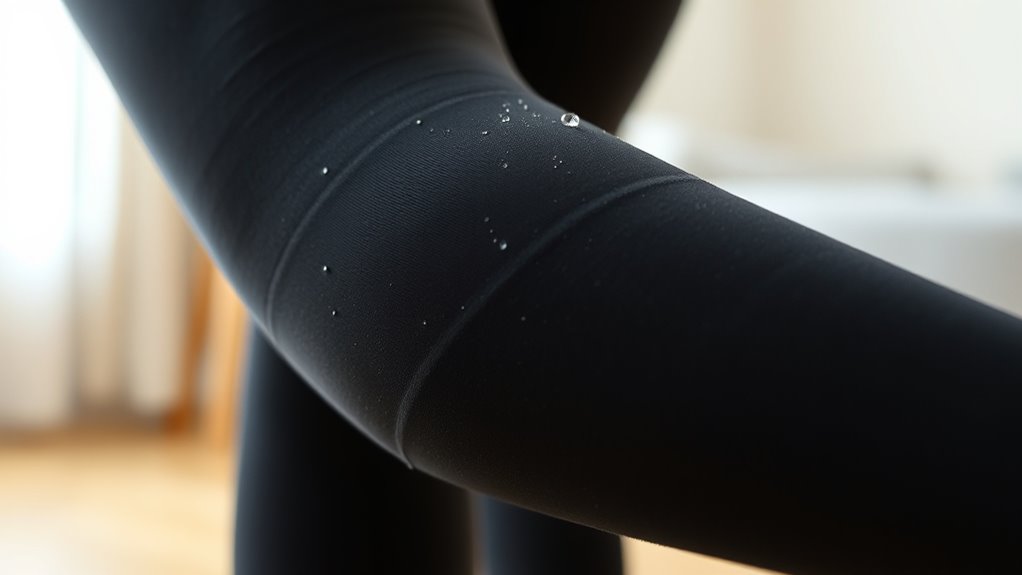
Choosing the right tights can make a significant difference in staying warm and comfortable throughout your day. Focus on selecting tights with thermal or insulating fabrics to boost warmth, especially in colder weather. Consider current fashion trends to find styles that suit your wardrobe, but don’t sacrifice functionality. Tights color options also matter—dark shades like black or navy absorb heat better, while lighter colors reflect it.
| Tip | Explanation |
|---|---|
| Fabric choice | Opt for wool blends or thermal materials for warmth. |
| Style & fit | Ensure a snug fit without being too tight for comfort. |
| Color options | Darker shades retain heat; vibrant colors add style. |
Frequently Asked Questions
Do Tights Provide Insulation in Extreme Cold Conditions?
Yes, tights do provide insulation in extreme cold conditions. Their insulation properties depend on fabric thickness, with thicker materials offering better warmth. When you wear tights made from dense, insulated fabrics, you trap body heat more effectively, helping to maintain your core temperature. Keep in mind, though, that in very severe cold, you might need additional layers since tights alone may not be sufficient for complete protection.
How Do Tights Affect Sweating and Moisture Management?
You might find that tights with moisture-wicking fabrics help manage sweat better by drawing moisture away from your skin. This keeps you dry and comfortable during activity. Good breathability in the fabric allows air to circulate, preventing excess moisture buildup. So, wearing tights designed with moisture wicking and breathable fabrics can improve moisture management, reduce chafing, and keep you feeling fresh even during intense workouts.
Can Tights Help Prevent Hypothermia During Outdoor Activities?
You might wonder if tights can prevent hypothermia during outdoor activities. While layering strategies and fabric breathability play vital roles, tights alone won’t fully protect you from extreme cold. They help wick moisture and insulate, but combining them with thermal layers and wind-resistant gear is essential. Proper layering maximizes warmth and manages sweat, reducing hypothermia risk. So, tights are helpful, but they need to be part of a thorough cold-weather strategy.
Are There Specific Fabrics Best for Temperature Regulation?
You want to know the best fabrics for temperature regulation. Look for materials with fabric properties like moisture wicking, which helps draw sweat away from your skin, keeping you dry and comfortable. Fabrics like merino wool, polyester, and nylon excel because they regulate temperature effectively and dry quickly. By choosing clothing with these properties, you’ll stay warmer when it’s cold and cooler when it’s hot, enhancing your outdoor experience.
How Does Body Movement Influence Heat Retention in Tights?
Like a skilled dancer, your movement influences muscle warmth and flexibility enhancement, impacting heat retention in tights. When you move, your muscles generate warmth, helping retain heat and preventing chill, especially during activity. Dynamic moves increase blood flow, maintaining muscle warmth and improving flexibility. So, your active efforts directly affect how well tights insulate, making movement a key factor in optimizing thermoregulation and comfort during exercise or cold weather.
Conclusion
Think of tights as a cozy shield, wrapping your body in a gentle embrace that guards against the chill. When chosen wisely, they become your warm fortress, balancing heat like a steady flame within. By understanding how fabric and your body’s natural defenses work together, you can walk through cold days with confidence. Embrace your tights as the silent guardians of comfort, turning chilly moments into a warm, steady glow that keeps you moving forward.
